Sawyer Essay
| CLOSE WINDOW |

|
University of Virginia |
|
The Question: Faulkner is known for creating a world, Yoknapatawpha, that he explores in his fictions. I wanted to explore how he uses the greater world at large, outside of the United States, to shape the world in Yoknapatawpha that he is building in the first four novels we have encountered. What insight can Digital Yoknapatawpha give me into Faulkner's use of the greater world at large? What I did: (a) I began my search with the most basic maps for each of the first four Yoknapatawpha texts we have read (Flags in the Dust, The Sound and the Fury, As I Lay Dying, and Light in August). I checked for the map to show "All Locations" and then looked to the inset map to the bottom right labeled "World". The results looked something like this (I just show the maps for The Sound and the Fury): 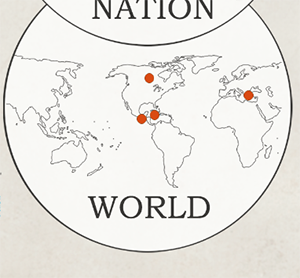 (b) I then recorded for each text the list of locations Faulkner incorporated into his text that fell outside of the United States. 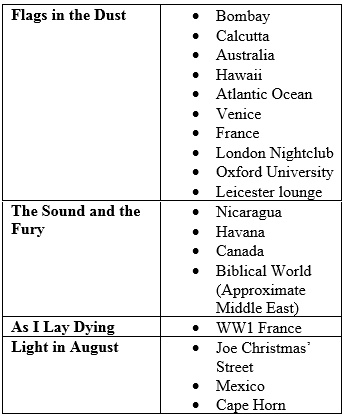 (c) I also wanted to look into the rest of Faulkner's texts to see if I could notice any patterns emerging, but didn't want to spoil the plot of the texts so I recorded only the number of outside locations each text used and recorded it like this: 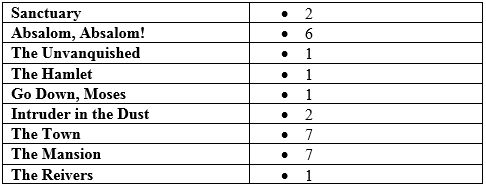 (d)Though this information was helpful it wasn't enough to draw any interpretative conclusions from. I found when clicking on each location on the original map, the text box that appears gives context about how the location is used in the text: most importantly, whether the locations were simply mentioned or if an actual event took place there. That looked something like this:  (e) I then recorded the results for the four texts we have encountered in class like this: 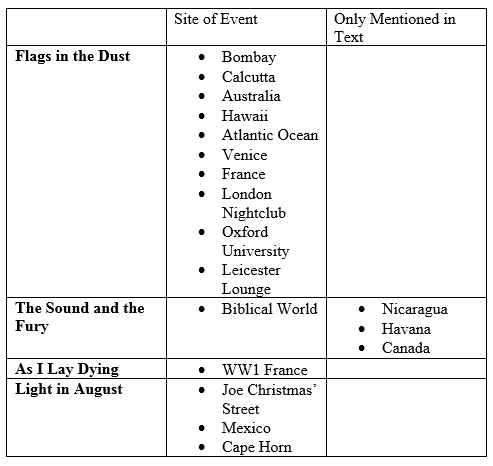 (f) Again I repeated this process for the other texts, but without looking at the specific events that occurred there. 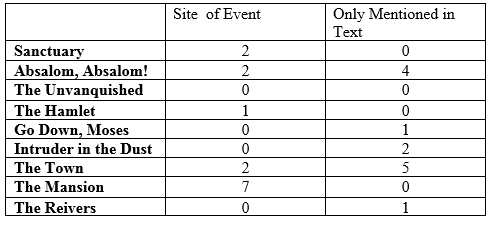 (g) I also wanted to see how these sites compared to locations both in Yoknapatawpha or the rest of the US as far as textual "heat" went. For each of the four texts we have read in class I looked at a heat map and compared the color to that of the rest of the map. I also repeated this process for the texts that we have not encountered yet in class. The results looked something like this: 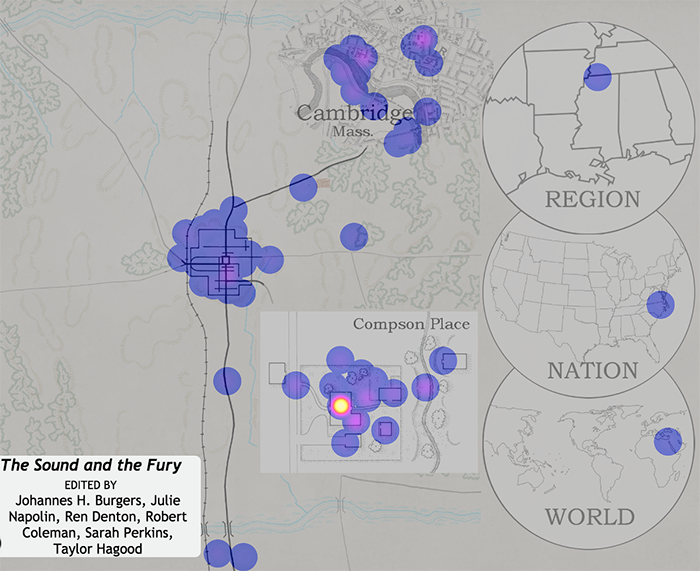 (h) I also thought it would be beneficial to look at who in the texts were mentioning or visiting the locations outside of Yoknapatawpha and the United States. I went to visualizations and clicked on "Location-Character Graphs" and then "Force Directed". From this point I used the qualifier "Location Type" to find places "Out of Yoknapatawpha" and the qualifier "Rank" to narrow the search to only "Major and Secondary Characters." 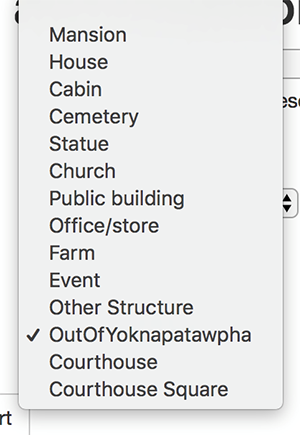 The results of this search looked like this: 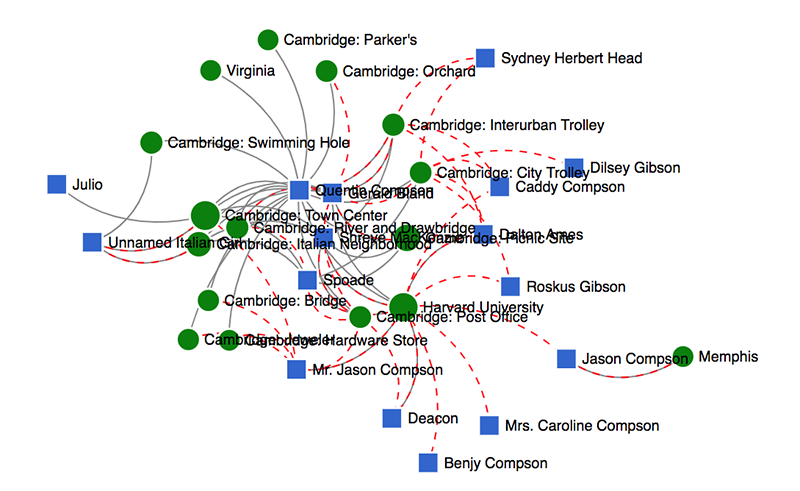 I then combed through each of the locations which are signaled by green dots to find, isolate, and graph the major and secondary characters connected to locations that were not only outside of Yoknapatawpha but also outside of the United States. I then recorded the characters and graphed them like this:  Interpretive Conclusions: The first few sets of graphs I looked at really allowed me to gather a sense of where and how often Faulkner was using the world outside the United States within his texts. In the four texts we've read this year Flags in the Dust has by far the most scenes in locations outside of the US. For me this made sense, as this is the novel where Faulkner is first bringing Yoknapatawpha into view and is figuring out how he wants to craft his world within the larger world's framework. As I Lay Dying by far had the least mentions of the four texts to the outside world. This to me also made sense as the socio-economic class of the Bundrens wouldn't have put them in a position to travel to much of the outside world or even know too much about the world outside without the excuse of a war, like WW1, to take them out of Yoknapatawpha. Both The Sound and the Fury and As I Lay Dying only have one site of events outside the world (though The Sound and the Fury has three more mentions of locations outside of the United States) which visually represents the kind of geographic claustrophobia these novels present to the reader. The Sound and the Fury and As I Lay Dying both are deeply rooted in Yoknapatawpha and this data only reinforces this. Light in August does not have the same geographic focus the previous two texts have which seemed to reflect the fact that the novels central characters are outsiders, this fact alone already opens the text up to include more of the world than say the Bundrens who are not only confined to Yoknapatawpha, but for whom a trip from Frenchman's Bend to Jefferson requires the space of a novel to explore. It is clear from how these texts vary in mentions of outside locations that Faulkner has a clear control on the texts and is intentional in his use of location to mimic either the claustrophobic feel of the text or the connection the characters would have had to the outside world. The information I gained from this first exercise was interesting and encouraged me to think deeply about the possible reasons for the different frequencies at which locations in the world at large appear; however, I don't think from this exercise alone I gained any new perspective on the texts or Faulkner as an author. When comparing this to the texts that we haven't read in class, I found it interesting that Faulkner's texts, as a whole, tend to have only few mentions of places outside the United States (with a few outliers: The Town, The Mansion and Absalom, Absalom!), especially The Unvanquished which has no out of the country references at all. This shows Faulkner's real focus of his texts is not the world at large, but the world he has created which he occasionally uses the world at large to mold. Though without more context of the plot of these texts I was limited in the conclusions I could draw. From the heat maps I learned that most of Faulkner's texts seem to have one center, which is most certainly always a location geographically in Yoknapatawpha. The rest of the world may come in to play, but is almost always purple or "cold" and the real "heat" of the novel is one location in Yoknapatawpha. Light in August had more than one real "hot" spot on the map, which I thought was interesting, but given that Lena and Joe Christmas, the two main characters never come in contact with each other, it makes sense that their geographic locations would be shown as separate spots of interest. Getting deeper into the who and where of the locations outside of the United States that Faulkner uses I found the most interesting conclusions. When looking at Flags and the Dust I was surprised to see several of the locations, especially some of the non-European locations were connected to Joan Heppleton. I thought it was possible Faulkner was using the exoticism of his locations to characterize Joan in a somewhat promiscuous manner—a contrast between herself and say Narcissa who did not have the same ties to foreign countries. Looking at the locations it is also clear that WW1 takes up a space in Faulkner's mind, it is included in multiple texts, even those that have seemingly little to do with it like As I Lay Dying. I also noticed the socio-economic class played a major role in both who can be connected to a location outside of the continental US and how they can use those locations. Quintin Compson and Horace Benbow can think about foreign places, because they both have the intellectual interiority to pull it off and the socio-economic status to be introduce to ideas about foreign places. Cash Bundren; however, is in no way interested in the world at large, he is interested in building a casket for his mother. This is also clear with where people can travel. Joe Christmas can walk a, metaphorical road that takes him through Mexico because he is travelling through the South and Mexico is nearby, he couldn't think about glassblowing in Venice though, because he was an orphan who had killed his adoptive father and not the nobility of Jefferson. I found this project incredibly thought provoking. The visual element allowed me to interact with a text in a way I hadn't previously experienced. I don't know if I necessarily learned anything extremely revelatory through my own exploration, but certainly was prompted to think about the texts more deeply than I had previously. I think a next step would be to look at locations outside of Yoknapatawpha but within the United States to see if Faulkner is using those locations differently than the outside world. I also am curious to see how many more patterns might develop if I had read more of his novels and could include that contextualization to the results. Another way to deepen the search would be to see if how Faulkner uses these locations changes throughout the book and throughout time as a whole. Is Faulkner more focus on the outside world at a certain point within the novels (i.e. beginning, end, etc.)? Is Faulkner interested in the world at large in certain time periods; for instance, it is clear he has a preoccupation with World War 1 but are there other world scale events he mentions repeatedly or places he uses to characterize people in the same way? Citing this source: |
